The Gryphon Audio Designs Diablo 333 Integrated Amplifier
Beauty and The Beast
The Gryphon Audio Designs Diablo 333 integrated amplifier is the highly anticipated, long-awaited replacement for the very successful Diablo 300, which had a remarkable 8-year run and sold thousands of units. This new design incorporates advanced technologies used in Gryphon's flagship Apex and Commander amplifier and preamp.
I met Anthony Chiarella, Gryphon's Director of Sales and Marketing for the USA, at AXPONA 2024. We talked about Gryphon's history, product development, and vision for the future. It's clear that Gryphon has a lot going on, and we can expect to see more results as the year progresses.
In the Gryphon room I met Rune Skov the International Sales Director of Gryphon Audio Designs where a Diablo 333 played, paired with Gryphon's new $52,800/pr. EOS5 Loudspeakers. It was my first time seeing/hearing the unit. Sitting on the rack with the striking Gryphon Ethos CD Player, it was a feast for the eyes.
Knowing that many current Diablo 300 owners would be interested, I asked Rune what specific sonic areas he felt the 333 improved on over the 300 and in what ways.
He responded: "This is always a subjective and individual assessment. But we find the Diablo 333 to be better when it comes to dissemination of width and depth of a recording, which reminds of true class A sound. On top of that, the 333 has more headroom, together with improved lower frequency definition."
I received the review unit shortly after the show, and I had to enlist some extra help to unbox and place the 122-lb Diablo 333 in my listening room. The new model is about 20 lbs heavier than the Diablo 300 it is replacing, and it is not a one-person lift (at least not for me).
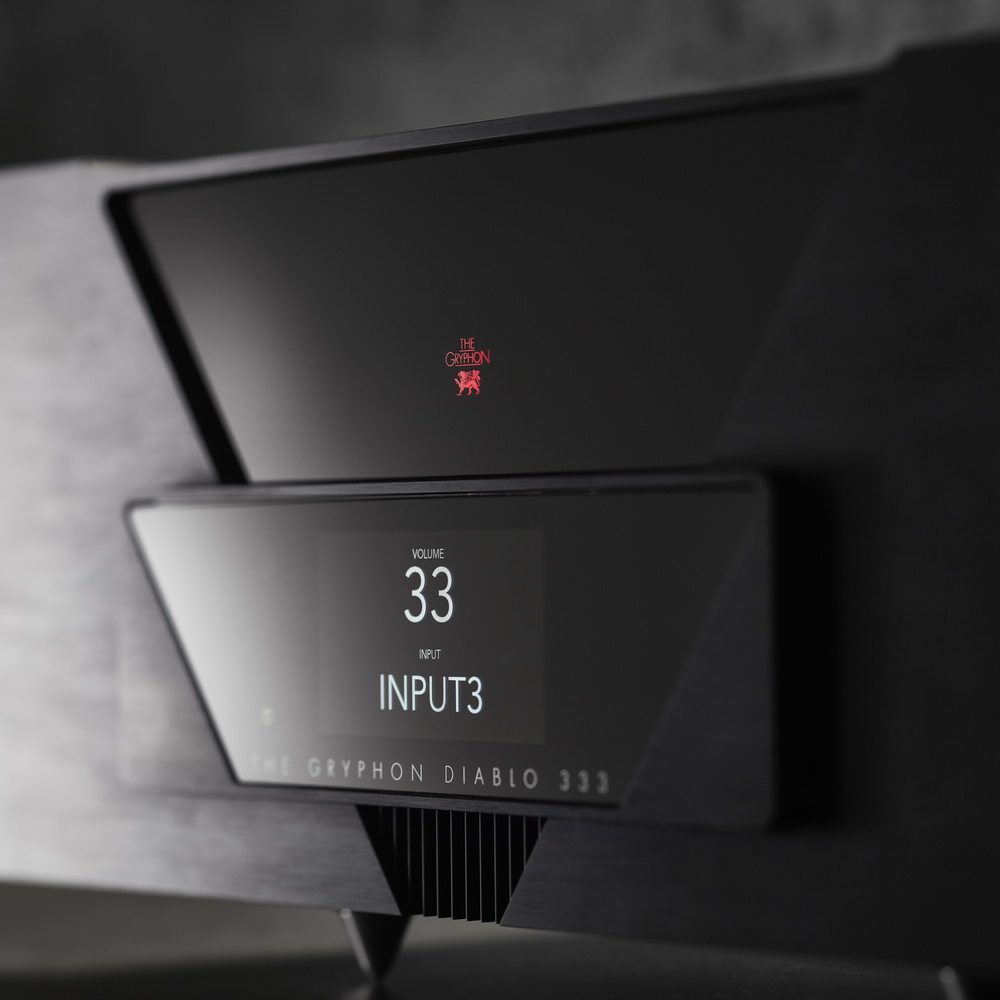 Gryphon founder Flemming E. Rasmussen designed the Diablo 333's distinctive Gryphon aesthetic appearance that features a triangular display panel and a 4.3" TFT capacitive touch screen protected by 4mm hardened glass. This design feature offers a modern, intuitive, user-friendly interface. The display reacted quickly to the touch, and the graphics were large, clear and easily viewable from my listening chair. (Thank you!)
Gryphon founder Flemming E. Rasmussen designed the Diablo 333's distinctive Gryphon aesthetic appearance that features a triangular display panel and a 4.3" TFT capacitive touch screen protected by 4mm hardened glass. This design feature offers a modern, intuitive, user-friendly interface. The display reacted quickly to the touch, and the graphics were large, clear and easily viewable from my listening chair. (Thank you!)
Every aspect of the thoroughly modern chassis design, from its custom-made, stability improving spikes to the thoughtfully rounded heat fins (Thank you!) enhances both visual appeal and mechanical sturdiness, with particular attention paid to providing shielding from today's ever-present external electrical gremlins.
The substantial, ergonomically efficient aluminum remote control fits well in the hand and allows for one-handed operation.
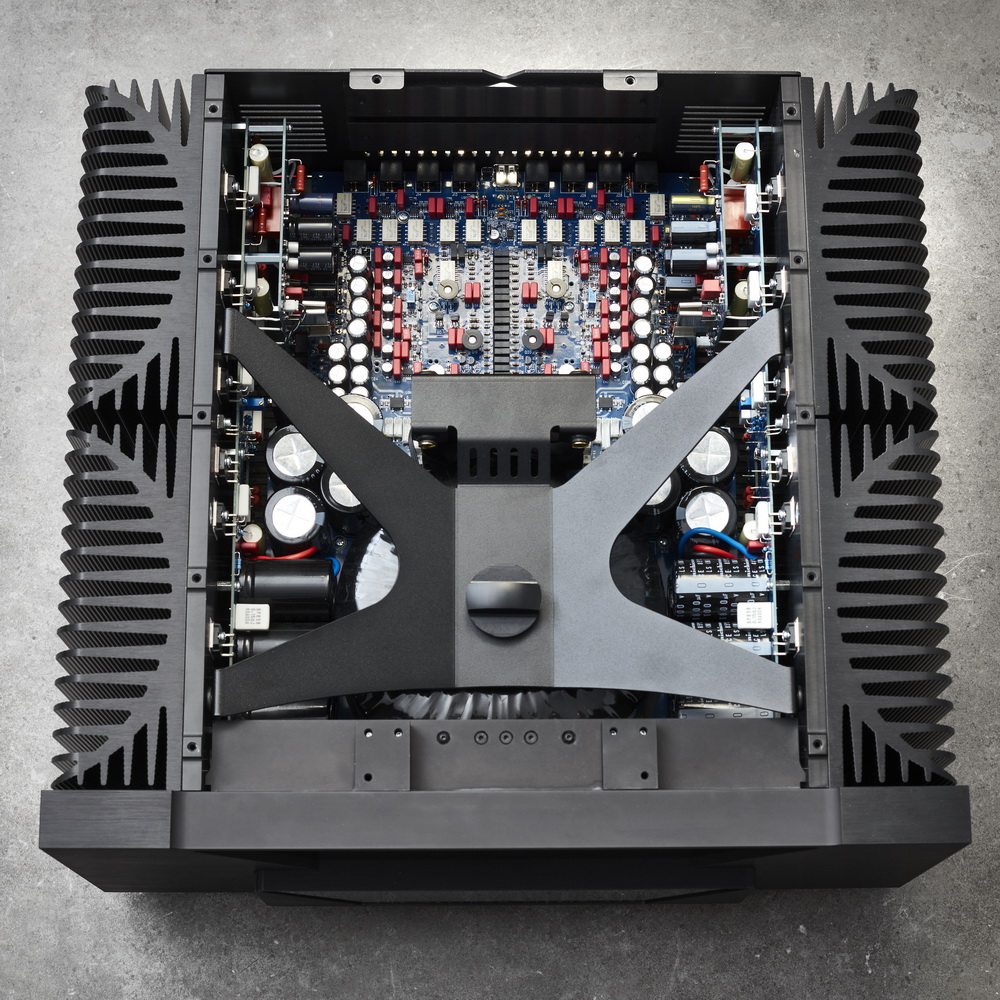 The Diablo 333 amplifier delivers 333 watts per channel at 8 ohms, 666 watts at 4 ohms, and 1100 watts at 2 ohms.
The Diablo 333 amplifier delivers 333 watts per channel at 8 ohms, 666 watts at 4 ohms, and 1100 watts at 2 ohms.
According to Gryphon's website:
"Circuit advancements and parts from the new Apex and Commander, Gryphon's flagship Amplifier and Preamplifier, have "Trickled-Down" to the Diablo 333. New, ultra-fast, pre-driver transistors deliver both enhanced musicality and superior measured performance while output devices—ten per channel—are identical to those found in our State-of-the-Art Apex. A massively augmented power supply distinguished by an oversized Holmgren Dual-Mono Transformer and 68,000uF per channel filter capacitance provide enormous dynamic headroom and explain the 333's 50.6 Kg (112 lb) mass."
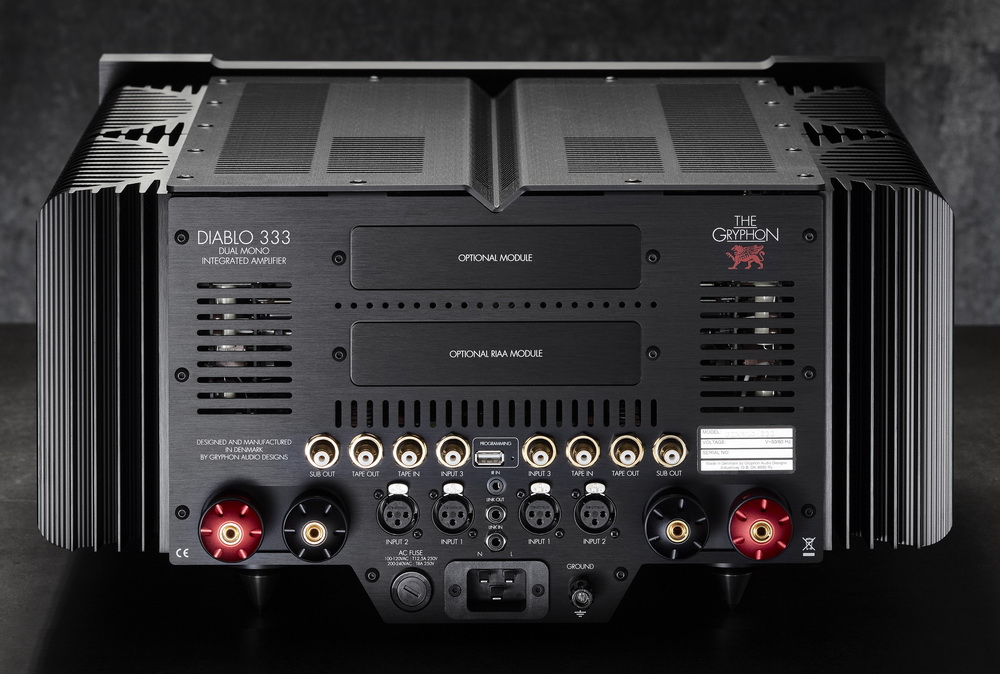 Other noteworthy features include:
Other noteworthy features include:
• True Dual Mono Configuration
• Zero Global Feedback
• Microprocessor-controlled, "bandwidth-optimized," 43-step true balanced relay volume attenuator featuring only 1-2 resistors in series at all signal levels.
I was unfamiliar with a "bandwidth-optimized" volume control and asked Rune what it meant and its sonic impact.
He explained:
"The series impedance in the volume control is lowered to approximately half of the volume series impedance in the Diablo 300. This increases transient handling and overall sonic clarity."
• Polypropylene capacitors for local power supply decoupling
• Four-layer printed circuit boards with 70µm copper on all layers
• USB 2.0 socket for future firmware upgrades
• Input level match
• Input naming
• Gryphon custom-built gold-plated binding post
• 12Vdc link input and output
• Output impedance: 0,015Ω
• Bandwidth (-3dB): 0,1Hz to 350 kHz
• Power Supply Capacity: 2 x 68.000uF
• Fixed-level AV throughput
• Modular design with optional Phono and DAC cards available
Gryphon Audio Designs offers optional PS-3 RIAA phono stage and DAC-3 digital-to-analog converter modules; both wholly redesigned from earlier Gryphon modules. The PS-3 features true dual mono Class A topology with no global negative feedback and externally adjustable MC load impedance. The DAC-3 module utilizes the latest ES9039PRO Sabre DAC and supports various audio formats, including PCM up to 384 kHz/32-bit and DSD512. It also offers seven user-selectable PCM digital roll-off filters for precise audio playback adjustments.
The DAC-3 module has a USB 2.0 input compatible with various digital formats and connections for USB, AES/EBU, BNC, and TOSLINK inputs. Unfortunately, the new modules are not compatible with the Diablo 300, so there's no upgrade path.
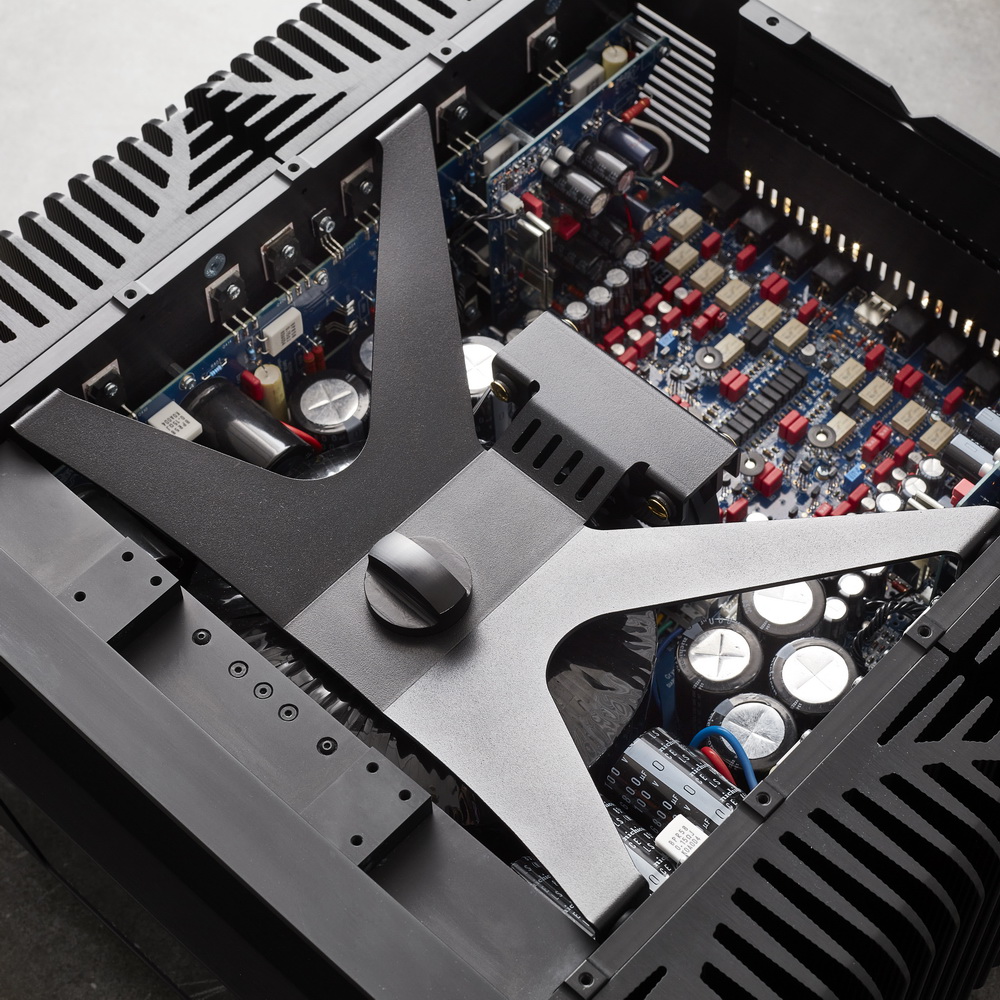 My review unit did not have the DAC-3 module installed, but it did have the Phono module. I was unable to audition the phono card because of my limited review time and the need to use a balanced phono cable.
My review unit did not have the DAC-3 module installed, but it did have the Phono module. I was unable to audition the phono card because of my limited review time and the need to use a balanced phono cable.
A couple of other details before we get into the sound of this component.
· Be aware that it uses a 20 amp IEC power cord connector.
· While it does incorporate an internal fan, it is exceptionally quiet, and I never heard it in my listening position. In fact, I had to be less than a foot away to notice it.
· The high bias A/B design runs warm at about 117 degrees by my infrared thermometer so you will want to give it some room to breathe.
Sounds Great So Far
The hookup process was quite simple. However, the binding posts placed low on the rear panel might be problematic for installations where the speaker cables must be positioned from the bottom. In my setup, the back of the amp extended slightly past the rear of the rack shelf, making it easy to attach my spade-terminated Cardas Clear Beyond cables to the excellent Diablo binding posts that connect to my Acora SRC-2 loudspeakers.
I liked the master power switch location directly under the unit's front center. Most manufacturers place it next to the power cord input on the back of the unit, which makes it inconvenient to reach around and turn off when, for example, a thunderstorm is predicted or before leaving for an extended period. Even though it may seem like a small detail, these things ultimately contribute to a more positive experience.
But How Does it Sound?
From the outset the Diablo 333 took control of my Acoras. There was simply no doubt who was running the show. The amp's vise-like grip on the Acora bass drivers was immediately apparent and not just because of its power capabilities. I have had numerous other amps on the Acoras—some more powerful. Compared to the Diablo 333, none of them produced the combination of power and control, laying a bedrock foundation for the music to rise from. Early Krell amps immediately came to mind.
The Diablo 333 builds the music from this power/control foundation. It possesses the much sought-after trifecta of bass power, speed, and definition and does this without polluting, darkening, or thickening the lower midrange.
The upper frequencies are much like the grain-free, airy, clarifying extension I would expect from a wide bandwidth high-biased A/B amplifier, with lightning-fast transient response free of harshness, producing the sensation that there's nothing between you and the music. The word that comes to mind is precision.
In the all-important midrange the Diablo 333 was dead neutral, providing a wide open window into the heart of the music where it delivered dynamic expressiveness with excellent localization of vocals and instruments while walking the narrow tightrope between being clinically analytical or overly warm. I came away thinking the Diablo 333, located in the heart of an audio system would be a great revealer of source component problems and speaker issues as well.
Here are a few notes on some albums I listened to during my 30-day audition
 Sunday Kind of Love
Sunday Kind of Love
Mary Stallings delivers a captivating and soulful rendition of this familiar song. Her voice communicates the full range of emotions without any sonic editorialization by the Diablo 333, which also accurately captures the subtlety of drummer Carl Adam's brushwork. Look up "tickling the ivories" in the dictionary, and you may be referred to pianist Eric Reed's performance midway (approximately 3:30) through this recording. But don't dare jump to it; enjoy the entire song.
The Daiblo 333 does an impressive job of recreating the Village Vanguard ambience, including the crowd noise and applause, allowing you to feel like you were there in the venue that night. The Diablo 333 allowed me to appreciate the amazing artistry of that evening by not getting in the way.
 Otis Taylor's Resurrection Blues from his White African album.
Otis Taylor's Resurrection Blues from his White African album.
Shortly after the music began, I wrote three things in my listening notes.
• Spatial coherency ( soundstage)
• Speed and Clarity
• Timing of higher frequency harmonics with the fundamental notes
The opening guitar segment on this cut can quickly tell you where your system will take you. The amplifier's speed and absence of grain, plus its neutral tonal balance locked me into the music. Adding to the musical pleasure was the life-like, unrestricted, dynamic expression of Otis's guitar playing.
It ended up being one of the more memorable presentations of this song I have experienced in my room.
OK ..It is Precise and Neutral… But Can it Get Your Toe Tapping?
Having all the characteristics I have mentioned is great, but the audio landscape is littered with components that qualify as Audio Microscopes—soulless components that tick all the boxes but, in the end, can't carry a tune.
Can the Diablo 333 recreate music? Can it invite you to join the experience and understand what the artist tries to communicate? Can it make you forget, if just for a moment , that you are listening to a collection of boxes? Does this hunk of metal, whose name literally means devil, have a soul?
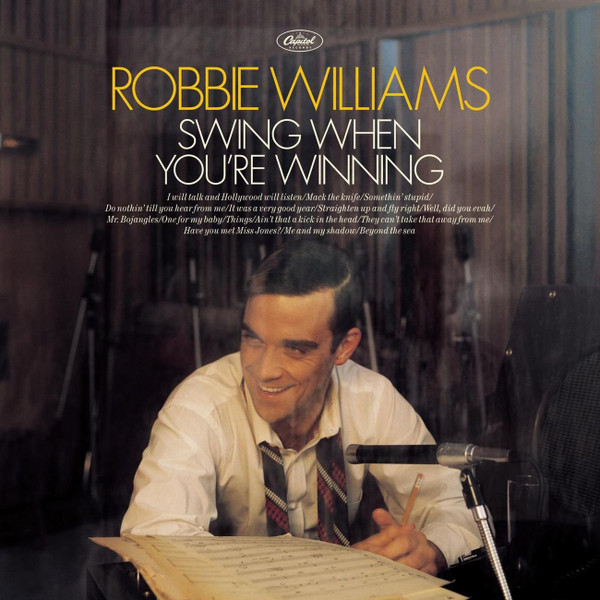 This is one of my "go to" albums when I want to see if a component gets my toes to tap. It is a crazy concoction of songs dedicated to Frank, Dean, and Sammy by Robbie Williams, joined by, among others, Jon Lovitz (!) and Nicole Kidman (!), backed by the London Session Orchestra. Al Schmitt recorded and mixed most of it with Doug Sax mastering it at the Mastering Lab, so you know it sounds good!
This is one of my "go to" albums when I want to see if a component gets my toes to tap. It is a crazy concoction of songs dedicated to Frank, Dean, and Sammy by Robbie Williams, joined by, among others, Jon Lovitz (!) and Nicole Kidman (!), backed by the London Session Orchestra. Al Schmitt recorded and mixed most of it with Doug Sax mastering it at the Mastering Lab, so you know it sounds good!
"Me and My Shadow" is a fun and lively song performed by Williams and Jonathan Wilkes, backed by the orchestra. It's a great listen, but if I'm not feeling the groove I quickly lose interest. "Beyond the Sea," made most famous by Bobby Darin follows, though Harry James recorded the Charles Trenet original in 1947.
If you're not tapping your feet to both of these, it might be time to check to see if your system's dashboard service light is on! Both through the Diablo 333, had me directing the orchestra from my seat and I could sense the humanity in the vocals and laughter in the songs. Dozens and dozens of other songs played through this amp found me consistently drawn into listening to the music and forgetting about the equipment. So yes, despite its devilish name, I am happy to report the Diablo has an angelic musical soul.
To investigate Rune's comment about Gryphon's attention to the Diablo 333's low-frequency definition I thought of Brian Bromberg's rendition of "Elephant on Ice Skates," in which he plays 4 and 5-string bass, a bass tenor bass, a hollow body ipccolo bass, and a solid body piccolo bass (not all of them simultaneously!). This song is a demanding system test that requires low frequency speed, definition, attack and power. The Diablo 333 did a impressive job correctly reproducing all of these instruments and showcasing its ability to maintain bass clarity and energy.
On "Hoist the Colors" by The Wellermen, the Diablo 333 powerfully reproduced the deep bass drum strikes with low coloration that allowed The Wellelrman's impressive bass vocals to be fully expressed without being "co-mingled" with the drum. Lesser amplifiers struggle in this region, adding slow, muddled and/or opaque bass. When the music demands it, the Diablo 333 produces prodigious yet well-controlled, highly resolved bass.
What Would I Change?
I struggle to find fault in any area of the 333's sonic performance. While I am sure "better" exists out there, I would speculate it would take multiples of the cost of the Diablo 333 to own it. Gryphon's Apex and Commander separates for instance, which cost in excess of $160K. While the 333's $24,900 price tag is significant coin, it does not feel out of line when viewed in today's audio marketplace.
A couple of nitpicks:
· I would like the volume buttons on the remote to be better differentiated. The monitor button is directly above the volume up button, and more than once, I would turn the volume up and hit the monitor button by mistake.
· I occasionally wanted a volume setting between two numbers on the 43-step volume control to get the perfect volume level for a particular song.
· The previously mentioned speaker binding post location.
Conclusion
The Diablo 333 offers reference sound quality featuring a dead-neutral tonal balance with powerful, detailed, well-controlled bass, grain-free clarity, effortless speed and precision, and life-like dynamic expression. It presents a large, wide, high, and deep soundstage with precise imaging. Additionally, the Diablo 333 boasts flawless fit and finish, along with an aesthetically pleasing, dare I say, artistic design, making it what I predict will be a resounding success for Gryphon Audio Designs.
The word "Gryphon" refers to a mythical creature with the head and wings of an eagle and the body of a lion. The beast guards the gold of the kings, as well as other priceless possessions. I can say that the Gryphon Diablo 333 guards our musical treasures very well indeed. The combination of its aesthetic design and sonic performance truly gave me "Beauty and the Beast" in one package. Yes, I was quite smitten with the Diablo 333's visit to my room.
Over a year's time, 12-15 pieces of equipment typically pass through my audio room. Some stay for a while, while others have a much shorter stint. And then there are those few pieces that leave a lasting impression and are seared in my memory. The Gryphon Diablo 333 is one of them.
I have no doubt this could be an "end game" component for many audio enthusiasts. It could also be the solution for someone accustomed to top-notch performance but looking to downsize their multi-component system without compromise. When the time comes for me to make that change, the Diablo 333 will unquestionably be on my shortlist.
It should be on yours.
Suggested Retail $24,900.00
PS-3 RIAA module $6,000.00
DAC-3 module $7,600.00
Review system:
Turntable: AMG Viella V12 JT
Cartridges: Micro Benz LP-S, Grado Statement 3
Phono Stage: Tom Evans Groove + SRX MK2.5
CD Transport: Jays Audio CDT-3 MK3, McCormack SST-1
Preamp: SMc Audio VRE-1C and VAC Master w/ phono option
Amplifier: SMc Audio GT23 DNA 0.5 Monoblocks
Digital: Innuos Zenith Mk III, Phoenix USB, and PhoenixNET, Mojo Audio Mystique X SE NC DAC
Speakers: Acora Acoustics SRC-2, REL S/510 six-pack ( disconnected for this review)
Tape: Crown CX 822, SX 824
Cables: Belden Iconoclast, Cardas, SilverSmith Fidelium, Genesis Absolute Fidelity, Shunyata, Triode Wire Labs
Accessories: Stillpoints Apertures and Ultra 2's, Kirmuss KA-RC-1, Wally Tools Cartridge setup gear
Power: Shunyata Denali 6000/T v2, Typhon T2
Specifications
Power: 2x333W@8Ω, 2x666W@4Ω, 2x1100W@2Ω
Output impedance: 0,015Ω
Bandwidth (-3dB): 0,1Hz to 350 kHz
Power Supply Capacity: 2 x 68.000uF
Gain: +38dB
SUB output gain: +12dB
Input Impedance, balanced (20-20000Hz): 50KΩ
Input Impedance, single ended (20-20000Hz): 30KΩ
Power consumption: ≤ 0.5W (standby), approx. 180W (idle)
AC voltage range: 110-120V OR 220-240V – not changeable.
Operating ambient temperature range: 15 - 30°C / 59 - 86°F
MENU-controlled functions:
Volume Max Level
Volume Start Level
Display Intensity: (100%-75%-50%-25%, Auto Dim and Auto OFF)
Infrared source (Front or Rear Panel)
Input Level Match
Input Naming
Dedicate Input 2 (XLR) or Input 3 (RCA) to Volume-Bypass AV-input
Restore Settings
Phono Stage MM/MC selection (optional)
DAC level and filter settings (optional)
Outer dimensions, W x D x H:
468mm x 472mm x 245mm 18.4in x 18.6in x 9.66in
Net weight:
50,6kg – 112lb
Shipping weight:
67,0kg – 148lb


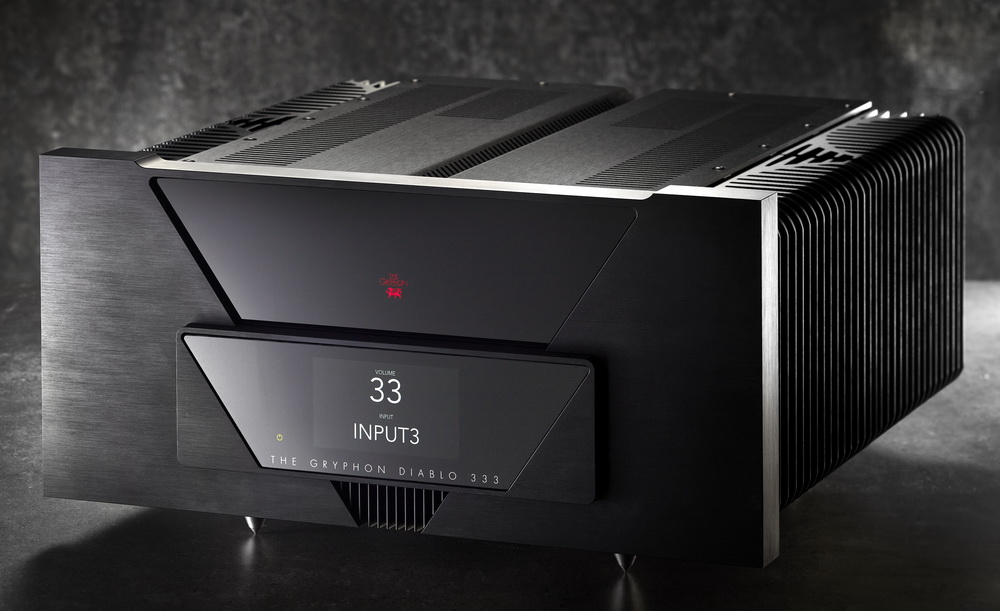
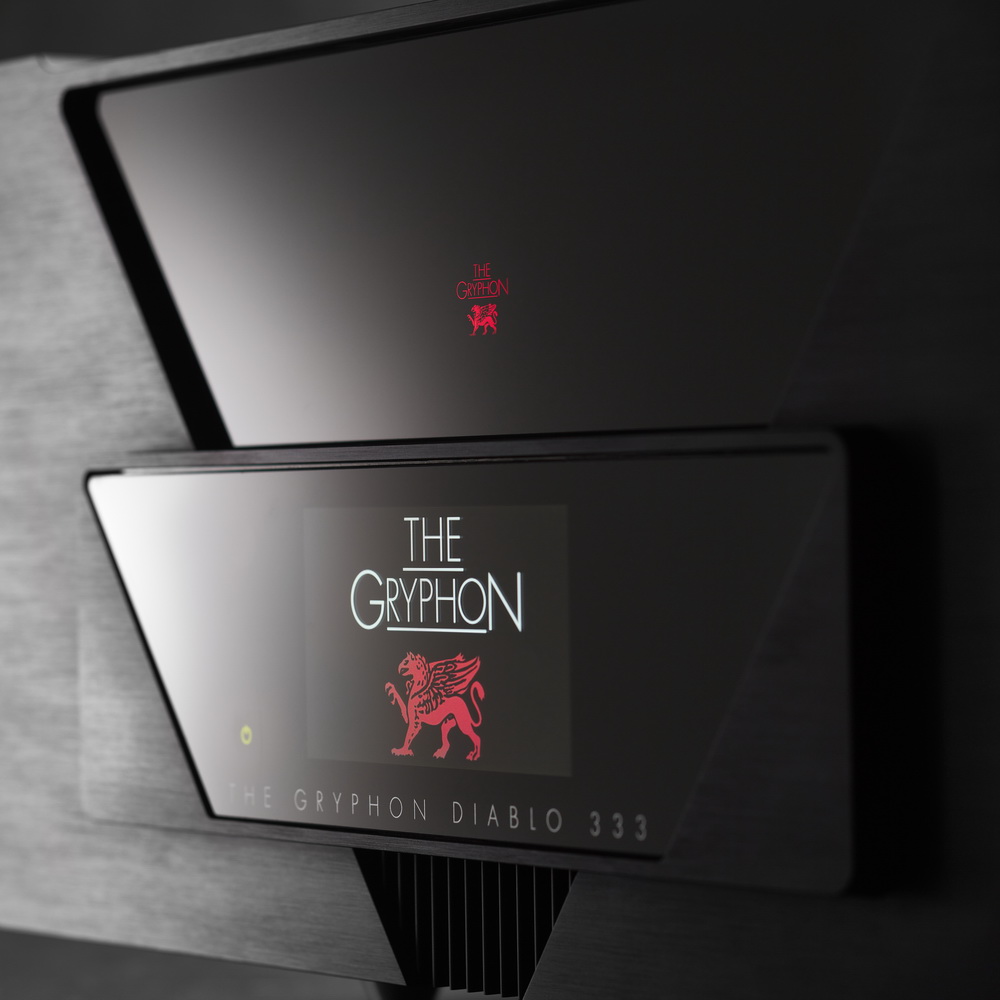






































.png)








